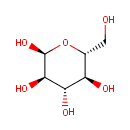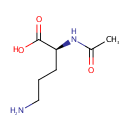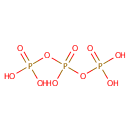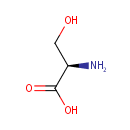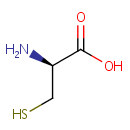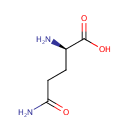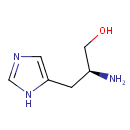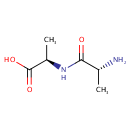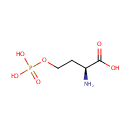
Search Results for compounds
Searching compounds for
returned 4373 results.
alpha-D-Glucose (PAMDB000492)
IUPAC:
(2S,3R,4S,5S,6R)-6-(hydroxymethyl)oxane-2,3,4,5-tetrol
CAS: 492-62-6
Description: Alpha-D-Glucose is a primary source of energy for living organisms. It is naturally occurring and is found in fruits and other parts of plants in its free state. Alpha-D-Glucose is an intermediate in glycolysis/gluconeogenesis pathway where it is converted to beta-D-glucose via galactose-1-epimerase (mutarotase) (EC:5.1.3.3). It is also involved in several other metabolic pathways: fructose and mannose metabolism, galactose metabolism, starch and sucrose metabolism and amino sugar and nucleotide sugar metabolism.
N-Acetylornithine (PAMDB000493)
IUPAC:
(2S)-5-amino-2-acetamidopentanoic acid
CAS: Not Available
Description: N-Acetylornithine is a intermediate in arginine and proline metabolism pathway. It is converted to ornithine via acetylornithine deacetylase (EC:3.5.1.16). (KEGG)
Nitric oxide (PAMDB000495)
IUPAC:
nitroso
CAS: 10102-43-9
Description: Nitric oxide or nitrogen monoxide is a chemical compound with chemical formula NO. This gas is an important signaling molecule in biological systems. It is also cytotoxic.
Triphosphate (PAMDB000496)
IUPAC:
{[hydroxy(phosphonooxy)phosphoryl]oxy}phosphonic acid
CAS: 14127-68-5
Description: A triphosphate is a salt or ester containing three phosphate groups. It is the ionic form of triphosphoric acid, a condensed form of phosphoric acid. Triphosphate is an intermediate in the biosynthesis of Folate, the metabolism of purine, the metabolism of Porphyrin, the metabolism of Pyrimidine and the metabolism of Thiamine. The cleavage of the high energy triphosphate bonds in ATP (to ADP or AMP) is the central route of generating energy in cells.
D-Serine (PAMDB000497)
IUPAC:
(2R)-2-amino-3-hydroxypropanoic acid
CAS: 312-84-5
Description: Serine is important in metabolism in that it participates in the biosynthesis of purines and pyrimidines. It is the precursor to several amino acids including glycine and cysteine, and tryptophan in bacteria. It is also the precursor to numerous of other metabolites, including sphingolipids and folate, which is the principal donor of one-carbon fragments in biosynthesis. Serine dehydratase is an enzyme that converts serine to pyruvate.
D-Cysteine (PAMDB000498)
IUPAC:
(2S)-2-amino-3-sulfanylpropanoic acid
CAS: 921-01-7
Description: Cysteine is a naturally occurring, sulfur-containing amino acid that is a building block to most proteins. Cysteine is unique among the twenty common amino acids because it contains a thiol group. Thiol groups can undergo oxidation of a pair of cysteine residues is oxidised produces cystine, a disulfide-containing derivative. This reaction is reversible. The disulphide bonds of cystine are crucial to defining the structures of many proteins. Related to its redox behavoir, cysteine is incorporated into many proteins that are redox-active, such as the antioxidant glutathione. Cysteine is named after cystine, which comes from the Greek word kustis meaning bladder &
D-Glutamine (PAMDB000500)
IUPAC:
(2R)-2-amino-4-carbamoylbutanoic acid
CAS: 5959-95-5
Description: D-glutamine is a non-essential amino acid and is involved in many metabolic processes. It is synthesized from glutamic acid and ammonia. It is the principal carrier of nitrogen and is an important energy source for many cells.
L-Histidinol (PAMDB000502)
IUPAC:
(2S)-2-amino-3-(1H-imidazol-5-yl)propan-1-ol
CAS: 4836-52-6
Description: L-Histidinol is a structural analogue of the essential amino acid L-histidine. It is an intermediate in histidine metabolism. It is converted to L-histidinal via bifunctional histidinal dehydrogenase/histidinol dehydrogenase (EC:1.1.1.23). (KEGG)
D-Alanyl-D-alanine (PAMDB000504)
IUPAC:
(2R)-2-[(2R)-2-aminopropanamido]propanoic acid
CAS: 923-16-0
Description: D-Alanyl-D-alanine is a component of peptidoglycan. The ATP-dependent carboxylate-amine/thiol ligase superfamily is known to contain enzymes catalyzing the formation of various types of peptide, one of which is D-alanyl-D-alanine.
O-Phosphohomoserine (PAMDB000505)
IUPAC:
(2S)-2-amino-4-(phosphonooxy)butanoic acid
CAS: 4210-66-6
Description: O-phosphohomoserine is a naturally occurring analogue of phosphonate amino acids. It is an intermediate in glycine, serine and threonine metabolism. It is comverted to L-threonine via threonine synthase (EC:4.2.3.1). (KEGG)
